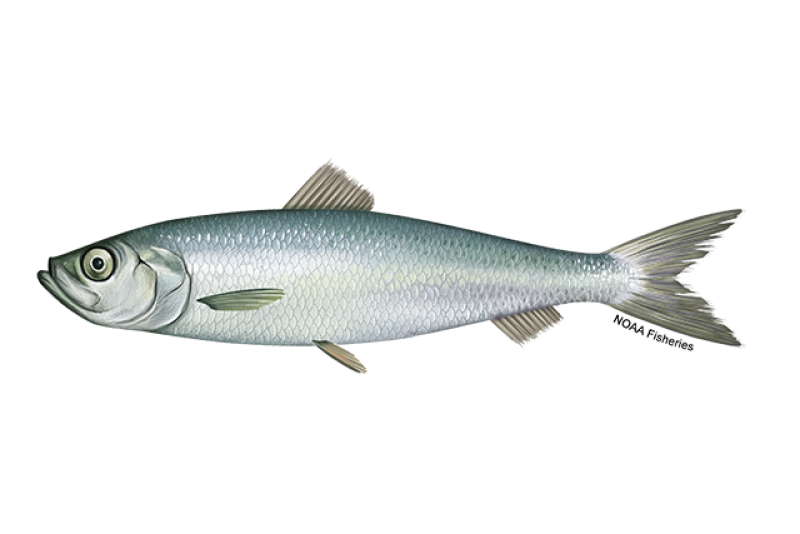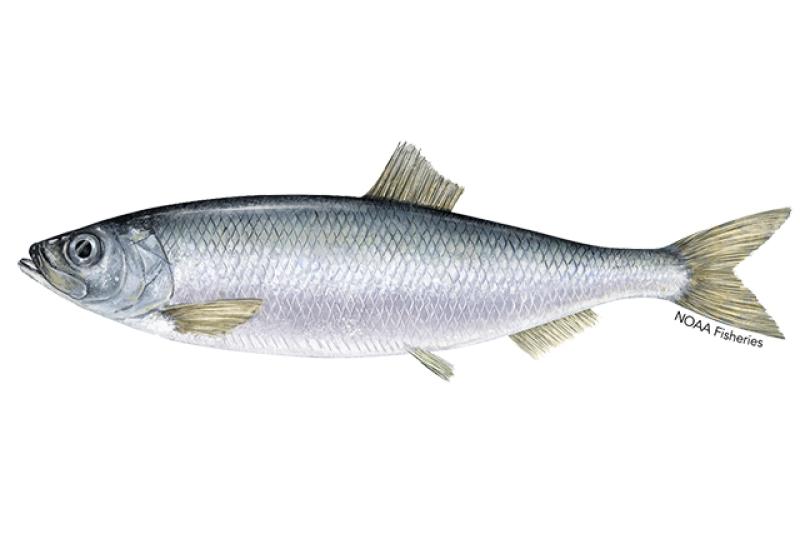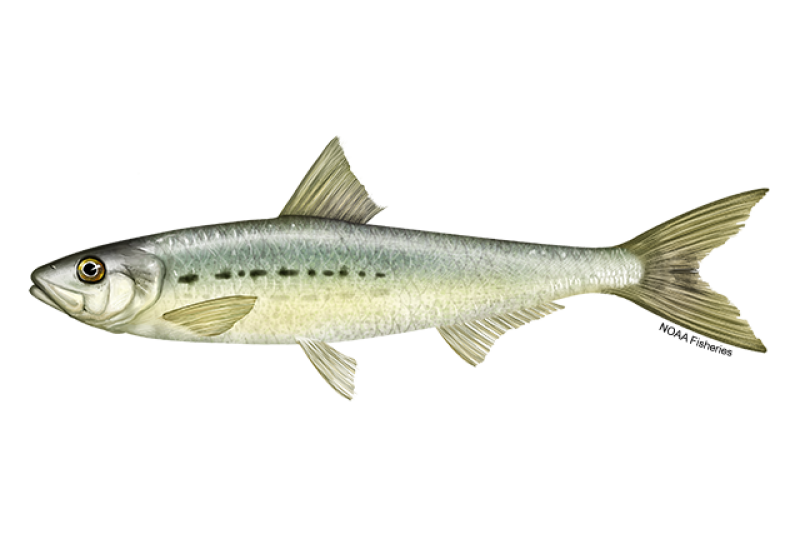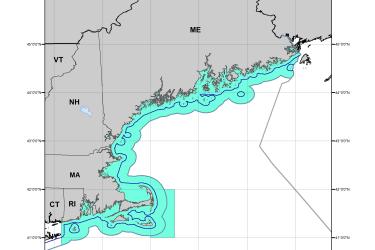Atlantic Herring
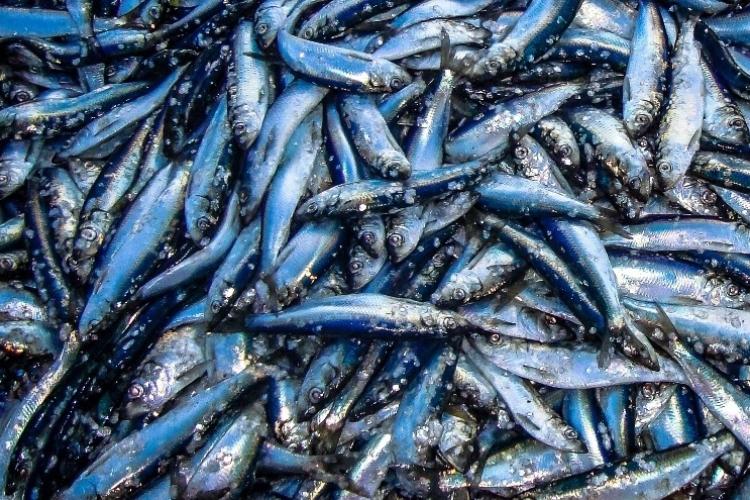 Atlantic herring. Credit: NOAA Fisheries/Calvin Alexander
Atlantic herring. Credit: NOAA Fisheries/Calvin Alexander
Atlantic herring. Credit: NOAA Fisheries/Calvin Alexander
About the Species
 Atlantic herring. Credit: NOAA Fisheries/Calvin Alexander
Atlantic herring. Credit: NOAA Fisheries/Calvin Alexander
Atlantic herring. Credit: NOAA Fisheries/Calvin Alexander
U.S. wild-caught Atlantic herring is a smart seafood choice because it is sustainably managed and responsibly harvested under U.S. regulations.

Population
The stock is overfished, but the fishing rate established under a rebuilding plan promotes population growth.

Fishing Rate
Not subject to overfishing.

Habitat Impact
Fishing gears used to harvest Atlantic herring have minimal impacts on habitat.

Bycatch
Regulations are in place to minimize bycatch.
Population Status
- According to the 2022 stock assessment, Atlantic herring is overfished, but not subject to overfishing. Summary stock assessment information can be found on Stock SMART.
- Herring populations are naturally highly variable.
Appearance
- Atlantic herring are small schooling fish.
- They are silvery in color, with a bluish or greenish-blue back.
Biology
- Atlantic herring are one of nearly 200 herring species in the family Clupeidae.
- They grow quickly, up to 14 inches.
- They can live up to 15 years.
- They are able to reproduce when they reach age 4.
- Atlantic herring migrate in schools to areas where they feed, spawn, and spend the winter.
- They spawn as early as August in Nova Scotia and eastern Maine and from October through November in the southern Gulf of Maine, Georges Bank, and Nantucket Shoals.
- Female herring can produce 30,000 to 200,000 eggs.
- They deposit their eggs on rock, gravel, or sand ocean bottom.
- Schools of herring can produce so many eggs that they cover the ocean bottom in a dense carpet of eggs several centimeters thick.
- The eggs usually hatch in 7 to 10 days, depending on temperature.
- By late spring, larvae grow into juvenile herring, which form large schools in coastal waters during the summer.
- Atlantic herring is an important species in the food web of the northwest Atlantic Ocean.
- A variety of bottom-dwelling fish—including winter flounder, cod, haddock, and red hake—feed on herring eggs.
- Juvenile herring are heavily preyed upon due to their abundance and small size. A number of fish, sharks, skates, marine mammals, and seabirds prey on herring.
- Atlantic herring feed on zooplankton (tiny floating animals), krill, and fish larvae.
Where They Live
Range
- Atlantic herring are found on both sides of the North Atlantic. In the western North Atlantic, they are found from Labrador to Cape Hatteras, North Carolina.
Habitat
- Atlantic herring are found in coastal and continental shelf waters.
Fishery Management
- The Atlantic States Marine Fisheries Commission coordinates management of the herring fishery in state waters, and the New England Fishery Management Council manages the fishery in federal waters. The two entities develop their regulations in close coordination. Individual states are responsible for implementing regulations recommended by the Atlantic States Marine Fisheries Commission, and NOAA Fisheries is responsible for implementing regulations recommended by the New England Fishery Management Council.
- Managed under the Atlantic Herring Fishery Management Plan and Interstate Fishery Management Plan for Atlantic Herring:
- Managed using an annual catch limit for the entire herring fishery that is based upon scientific information on the status of the stock.
- The annual catch limit is divided into four area-specific sub-annual catch limits. When an area-specific limit is reached, the directed fishery in that area is closed and only incidental catches of herring are allowed.
- A limited access permit program limits the number of vessels that can participate in the directed fishery for herring. Vessels that do not qualify for a limited access permit can be issued an open access permit, allowing them to harvest a small amount of herring (6,600 pounds) per day or per trip.
- Managers limit the amount of herring a vessel can possess in one day or on one trip, depending on the type of permit it holds.
- The Interstate Fishery Management Plan for Atlantic Herring contains measures that close areas to herring fishing when herring are spawning.
- A rebuilding plan to rebuild the stock to the target population level is in place with a target date of 2026.
Harvest
- Commercial fishery:
- In 2023, commercial landings of Atlantic herring totaled approximately 21.6 million pounds and were valued at $7.7 million, according to the NOAA Fisheries commercial fishing landings database.
- During the past decade, the United States has accounted for 78 percent of the total herring harvest, with Canada harvesting the remainder.
- The Atlantic herring fishery is extremely valuable to the economy in the Northeast United States. Herring are sold frozen, salted, or canned as sardines in both U.S. and international markets and provide affordable bait to fishermen targeting lobster, blue crab, and tuna.
- Gear types, habitat impacts, and bycatch:
- Historically, Gulf of Maine herring were harvested along the coast in fixed-gear weirs (a fence of long stakes driven into the ground with nets arranged in a circle). Today, herring are primarily harvested by mid-water trawlers and purse seiners.
- Mid-water trawlers deploy and tow a net in the water column to catch schooling fish such as herring. The large front end of the net herds schooling fish toward the narrow back end, where they become trapped.
- Purse seiners catch schooling fish near the surface by encircling them with a net. When the net is around the school, fishermen lift up a wire that runs through the bottom of the net, closing the “purse” from below.
- Fisheries that harvest groundfish (such as cod and haddock) and herring operate in the same areas during the same seasons. Herring vessels may incidentally catch groundfish (mainly haddock). Managers set a cap on the amount of haddock that can be caught by the herring midwater trawl fishery.
- The Atlantic herring fishery can incidentally catch marine mammals. Currently, these takes are below limits that would require mitigation under the Marine Mammal Protection Act.
- Management measures to reduce marine mammal interactions include research, outreach to educate fisherman about actions they can take in the event of a marine mammal interaction, and efforts to communicate interaction hotspots to fishermen.
- In 2023, recreational anglers landed 462,000 pounds of Atlantic herring, according to the NOAA Fisheries recreational fishing landings database.
Scientific Classification
- Atlantic herring are found on both sides of the North Atlantic. In the western North Atlantic, they are found from Labrador to Cape Hatteras, North Carolina.
- Atlantic herring are found in coastal and continental shelf waters.
Fishery Management
- The Atlantic States Marine Fisheries Commission coordinates management of the herring fishery in state waters, and the New England Fishery Management Council manages the fishery in federal waters. The two entities develop their regulations in close coordination. Individual states are responsible for implementing regulations recommended by the Atlantic States Marine Fisheries Commission, and NOAA Fisheries is responsible for implementing regulations recommended by the New England Fishery Management Council.
- Managed under the Atlantic Herring Fishery Management Plan and Interstate Fishery Management Plan for Atlantic Herring:
- Managed using an annual catch limit for the entire herring fishery that is based upon scientific information on the status of the stock.
- The annual catch limit is divided into four area-specific sub-annual catch limits. When an area-specific limit is reached, the directed fishery in that area is closed and only incidental catches of herring are allowed.
- A limited access permit program limits the number of vessels that can participate in the directed fishery for herring. Vessels that do not qualify for a limited access permit can be issued an open access permit, allowing them to harvest a small amount of herring (6,600 pounds) per day or per trip.
- Managers limit the amount of herring a vessel can possess in one day or on one trip, depending on the type of permit it holds.
- The Interstate Fishery Management Plan for Atlantic Herring contains measures that close areas to herring fishing when herring are spawning.
- A rebuilding plan to rebuild the stock to the target population level is in place with a target date of 2026.
Harvest
- Commercial fishery:
- In 2023, commercial landings of Atlantic herring totaled approximately 21.6 million pounds and were valued at $7.7 million, according to the NOAA Fisheries commercial fishing landings database.
- During the past decade, the United States has accounted for 78 percent of the total herring harvest, with Canada harvesting the remainder.
- The Atlantic herring fishery is extremely valuable to the economy in the Northeast United States. Herring are sold frozen, salted, or canned as sardines in both U.S. and international markets and provide affordable bait to fishermen targeting lobster, blue crab, and tuna.
- Gear types, habitat impacts, and bycatch:
- Historically, Gulf of Maine herring were harvested along the coast in fixed-gear weirs (a fence of long stakes driven into the ground with nets arranged in a circle). Today, herring are primarily harvested by mid-water trawlers and purse seiners.
- Mid-water trawlers deploy and tow a net in the water column to catch schooling fish such as herring. The large front end of the net herds schooling fish toward the narrow back end, where they become trapped.
- Purse seiners catch schooling fish near the surface by encircling them with a net. When the net is around the school, fishermen lift up a wire that runs through the bottom of the net, closing the “purse” from below.
- Fisheries that harvest groundfish (such as cod and haddock) and herring operate in the same areas during the same seasons. Herring vessels may incidentally catch groundfish (mainly haddock). Managers set a cap on the amount of haddock that can be caught by the herring midwater trawl fishery.
- The Atlantic herring fishery can incidentally catch marine mammals. Currently, these takes are below limits that would require mitigation under the Marine Mammal Protection Act.
- Management measures to reduce marine mammal interactions include research, outreach to educate fisherman about actions they can take in the event of a marine mammal interaction, and efforts to communicate interaction hotspots to fishermen.
- In 2023, recreational anglers landed 462,000 pounds of Atlantic herring, according to the NOAA Fisheries recreational fishing landings database.
Scientific Classification
| Kingdom | Animalia | Phylum | Chordata | Class | Actinopterygii | Order | Clupeiformes | Family | Clupeidae | Genus | Clupea | Species | harengus |
|---|
Last updated by NOAA Fisheries on 12/23/2025
Featured News
 Juvenile coho salmon. Credit: iStock
Juvenile coho salmon. Credit: iStock
NOAA Fisheries Releases 2023 Status of Stocks

River Herring Science in Support of Species Conservation and Ecosystem Restoration
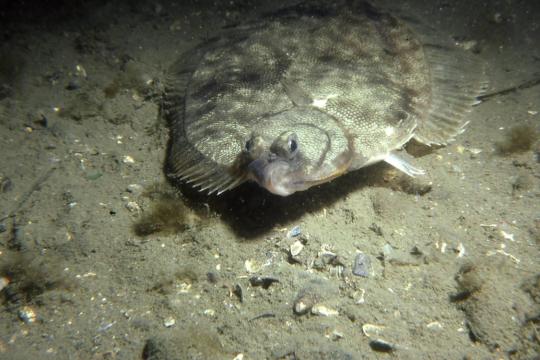 Winter flounder (Pseudopleuronectes americanus) in Narragansett Bay. It is a flatfish native to coastal waters of the western North Atlantic coast from Labrador to Georgia, although it is less common south of Delaware Bay. It feeds on bottom-dwelling animals. Photo: NOAA Fisheries
Winter flounder (Pseudopleuronectes americanus) in Narragansett Bay. It is a flatfish native to coastal waters of the western North Atlantic coast from Labrador to Georgia, although it is less common south of Delaware Bay. It feeds on bottom-dwelling animals. Photo: NOAA Fisheries
Predator-Prey Interaction Study Reveals More Food Does Not Always Mean More Consumption

Commercial Fishing Regulations
Atlantic Herring Specifications
2026 Atlantic Herring Specifications
Fishing year 2026 specifications were projected through the 2025–2027 herring specifications rule, and implemented on December 23, 2025, to lessen the risk of overfishing and help rebuild the herring stock.
2026 Herring Specifications
Specifications | 2026 Value (mt) |
Overfishing Limit | 23,491 |
Acceptable Biological Catch | 13,165 |
Management Uncertainty | 4,031 |
Annual Catch Limit/Optimum Yield | 9,134 |
Domestic Annual Harvest | 9,134 |
Border Transfer | 0 |
Domestic Annual Processing | 9,134 |
US At-Sea Processing | 0 |
Area 1A Sub-ACL (28.9%) | 2,640* |
Area 1B Sub-ACL (4.3%) | 393 |
Area 2 Sub-ACL (27.8%) | 2,539 |
Area 3 Sub-ACL (39%) | 3,562 |
Fixed Gear Set-Aside | 30 |
Research Set-Aside | 0% |
* If New Brunswick weir landings are less than 2,600 mt through October 1, then 1,000 mt will be subtracted from the management uncertainty and reallocated to the Area 1A sub-ACL and the ACL.
Herring Possession Limits
Vessels fishing for herring that are less than 165 feet in length overall, less than 750 gross registered tons, or less than 3,000 shaft horsepower may be issued one of the herring permits listed below. Herring vessels exceeding the size and horsepower restrictions may be issued a herring at-sea processing permit.
Possession Limits by Permit Category
| Permit Category | Description | Possession Limit |
| A | All Areas Limited Access | Unlimited in all areas |
| B | Areas 2/3 Limited Access | Unlimited in Areas 2/3 |
| C | Incidental Catch Limited Access | 55,000 lb per trip/day in all areas |
| D | Open Access | 6,600 lb per trip/day in all areas |
| E* | Open Access | 20,000 lb per trip/day in Areas 2, 3 |
*Any vessel issued a limited access mackerel permit can be issued this herring open access permit
Possession Limit Adjustments
The possession limits in the table above apply unless one of the following possession limit adjustments are in effect.
Fishery and Management Area Possession Limit Adjustments
- When 95 percent of the Area 1A or Area 1B sub-ACL has been caught, the herring possession limit in those areas is reduced to 2,000 pounds for the remainder of the fishing year.
- When 90 percent of the Area 2 or Area 3 sub-ACL is caught, the herring possession limit in those areas is reduced to 40,000 pounds for the remainder of the fishing year.
- When 98 percent of the Area 2 or Area 3 sub-ACL is caught, the herring possession limit in those areas is reduced to 2,000 pounds for the remainder of the fishing year.
- When 95 percent of the herring ACL is caught, the herring possession limit in all areas is reduced to 2,000 pounds for the remainder of the fishing year.
To see how much of a sub-ACL or the ACL has been caught by the herring fishery, please visit our herring quota monitoring page.
River Herring/Shad Catch Cap Closures
When 95 percent of a river herring/shad catch cap allocated to the herring fishery has been caught, the herring possession limit for vessels fishing with the specified gear type in the applicable catch cap closure area is reduced to 2,000 pounds for the remainder of the fishing year. To see how much of a river herring/shad catch cap has been caught by the herring fishery, please visit our river herring/shad catch cap monitoring page.
Haddock Incidental Catch Cap Closures
When the Gulf of Maine and/or Georges Bank incidental catch cap for haddock has been caught, a 2,000-pound herring possession limit will be implemented for herring vessels fishing with midwater trawl gear in the applicable accountability measure area for the remainder of the fishing year. To see how much of a haddock incidental catch cap has been caught by the herring fishery, please visit our haddock incidental catch cap monitoring page.
Fishing in Groundfish Closed Areas
Vessels may fish with midwater trawl gear inside groundfish closed areas on herring trips if the following criteria are met:
- The vessel declares its intent to fish in groundfish closed areas.
- The trip is assigned SBRM coverage in PTNS.
- The vessel carries a NEFOP observer on the trip.
If all the above criteria have been met, vessels may fish with midwater trawl gear on herring trips in the following groundfish closed areas:
- Cashes Ledge Closure Area.
- Western Gulf of Maine Closure Area.
- Closed Area 1 North (February 1 - April 15).
- Closed Area II.
For maps, coordinates, and more information about these closed areas, please visit our groundfish closed areas webpage.
Slippage Prohibition
Slippage in the Atlantic herring fishery means discarded catch from a vessel issued an Atlantic herring permit that is carrying a NOAA Fisheries-certified observer or monitor prior to the catch being brought on board or prior to the catch being made available for sampling and inspection by a NOAA Fisheries-certified observer or monitor after the catch is on board. Slippage also means any catch that is discarded during a trip prior to it being sampled portside by a portside sampler on a trip selected for portside sampling coverage by NOAA Fisheries. Slippage includes releasing catch from a codend or seine prior to the completion of pumping the catch aboard and the release of catch from a codend or seine while the codend or seine is in the water. Fish that cannot be pumped and remain in the codend or seine at the end of pumping operations are not considered slippage. Discards that occur after the catch is brought on board and made available for sampling and inspection by a NOAA Fisheries-certified observer or monitor are also not considered slippage.
Vessels may make test tows without pumping catch on board, provided that all catch from test tows is available to the observer when the next tow is brought aboard.
Slippage does not include operational discards, discards that occur after the catch is brought on board and made available for sampling and inspection by a NOAA Fisheries-certified observer or monitor, or fish that inadvertently fall out of or off fishing gear as gear is being brought on board the vessel
Exceptions from Slippage Prohibition
Limited Access herring vessels (Category A, B, C) may slip catch if:
- Pumping the catch aboard could compromise safety;
- Mechanical failure prevents the catch from being pumped aboard; or
- Spiny dogfish have clogged the pump and prevent the catch from being pumped aboard.
Slippage Consequence Measure
If a vessel issued any limited access herring permit slips catch, the vessel operator must report the slippage event on the Atlantic herring daily VMS catch report and indicate the reason for slipping catch. Additionally, the vessel operator must complete and sign a released catch affidavit form, which is available on the Greater Atlantic Region Forms and Applications Summary webpage. The released catch affidavit must detail:
- Why catch was slipped;
- An estimate of the quantity and species composition of the slipped catch; and
- The time and location of the slipped catch.
The completed affidavit must be submitted to NOAA Fisheries within 48 hr of the end of the trip.
If a vessel issued a Category A or B Herring permit slips catch for any of the reasons described in the section above (see “Exceptions for Slippage Prohibitions”), the vessel operator must move at least 15 nm from where the slippage event occurred before deploying any gear again, and must stay at least 15 nm away from the slippage event location for the remainder of the fishing trip.
If a vessel issued a Category A or B herring permit slips catch for any reason not described in the section above, the vessel operator must immediately terminate the trip and return to port. No fishing activity may occur during the return to port.
Commercial Gear Information
Minimum mesh size
Not applicable.
Other Gear Restrictions
The use of midwater trawl gear is prohibited in Area 1A from June 1 to September 30.
Herring as Bait
Vessels may possess herring solely for personal use as bait without holding a herring permit as long as the vessel does not have purse seine, midwater trawl, pelagic gillnet, sink gillnet, or bottom trawl gear on board.
Vessels may use pelagic gillnets to catch herring for use as bait. Pelagic gillnet gear is defined as a single gillnet not longer than 300 feet and not greater than 6 feet deep, with a maximum mesh size of 3 inches. The pelagic gillnet must be attached to the vessel and fished in the upper two-thirds of the water column.
Herring Roe
A vessel issued a herring permit may possess herring roe provided that the carcasses of the herring from which it came are not discarded at sea.
Herring Vessels Working Cooperatively
Each vessel working cooperatively in the herring fishery, including vessels pair trawling, purse seining, and transferring herring at-sea, must be issued a valid herring permit to fish for, possess, or land Atlantic herring and are subject to the most restrictive herring possession limit associated with the permits issued to vessels working cooperatively.
Herring Carrier Vessels
Atlantic herring carrier vessels operating under a letter of authorization or an Atlantic herring carrier VMS trip declaration may not possess, transfer, or land any species other than Atlantic herring, except that they may possess Northeast multispecies transferred by vessels issued either Category A or B Herring Permit, consistent with the applicable possession limits for such vessels.
More Information
- Inseason Adjustment to the 2025 Specifications
- 2024 Notification, Reporting, and Monitoring Requirements for the Herring Fishe…
- Atlantic Herring Permits
- Atlantic Herring Quota Monitoring
- River Herring/Shad Catch Cap Monitoring
- Haddock Incidental Catch Cap Monitoring
- Atlantic Herring Regulated and Closed Areas
- Fishing Industry Home Page
Last updated by NOAA Fisheries on 12/23/2025
Seafood Facts

Is Atlantic Herring Sustainable?
U.S. wild-caught Atlantic herring is a smart seafood choice because it is sustainably managed and responsibly harvested under U.S. regulations.
Availability
Year-round. Most of the herring eaten in the United States is canned and either pickled or smoked.
Source
U.S. wild-caught from Maine to North Carolina.
Taste
Small fresh herring have a more delicate flavor, while larger herring have a fuller, oilier flavor.
Texture
The meat of fresh herring is soft.
Color
The meat of fresh herring is off-white.
Health Benefits
Atlantic herring are a great source of omega-3s, vitamin B12, and iron.
Nutrition Facts
Servings: 1; Serving Weight: 100 g (raw) ; Calories: 158; Protein: 17.96 g ; Total Fat: 9.04 g; Total Saturated Fatty Acids: 2.04 g; Carbohydrate: 0 g; Total Sugars: 0 g; Total Dietary Fiber: 0 g; Cholesterol: 60 mg; Selenium: 36.5 mcg; Sodium: 90 mgSustainable Seafood Recipes
Looking for a new seafood recipe or an old favorite? If you need some cooking inspiration, browse these seafood recipes for main dishes, appetizers, sides, and more!
Last updated by NOAA Fisheries on 12/23/2025
Seafood News
 Credit: NOAA Fisheries and Partners
Credit: NOAA Fisheries and Partners
Part 2: Seafood Tips from the People Bringing You America's Seafood
 Commercial fishing boats lined up in Sitka, Alaska. Credit: Shutterstock.
Commercial fishing boats lined up in Sitka, Alaska. Credit: Shutterstock.
NOAA Fisheries Seeks Recommendations for Restoring American Seafood Competitiveness

Celebrate Seafood This Holiday Season

Part 1: Seafood Tips from the People Bringing You America's Seafood
Exempted Fishing
The Northeast Multispecies (Groundfish) Fishery Management Plan prohibits fishing with small-mesh bottom trawl gear, except in specific exemption areas. These exemption areas are summarized here. For additional information about the specific requirements for each area, including possession limit and gear requirements, please visit the area-specific webpages linked within the tables below.
A Letter of Authorization (LOA) is required to fish participate in some of these exemption areas. You can apply for a Letter of Authorization through your Fish Online account. If you need help with the online application or setting up an account, or have any other questions about the online forms and applications, please contact our Permits Office at (978) 282‐8438 between 8 a.m. and 4:30 p.m. ET or email NMFS.GAR.Permits@noaa.gov.
Gulf of Maine and Georges Bank Small-Mesh Exemption Areas
Atlantic herring may be retained by vessels fishing with small-mesh bottom trawl gear in the exemption areas listed in the table below, provided vessels meet the following criteria:
- Comply with all applicable season, area, and gear requirements.
- Comply with all applicable possession limits.
- Are issued a whiting (Category K Open Access Northeast Multispecies) permit or a limited access Northeast multispecies permit.
Herring is considered an incidentally-caught species in these exemption areas; therefore, in order to fish with small-mesh bottom trawl in these areas, vessels must be on a trip targeting whiting
| Area Name | Season | LOA Required? | River Herring/Shad Retention Allowed? |
|---|---|---|---|
| Gulf of Maine Grate Raised Footrope Trawl Whiting Fishery Exemption Area | July 1 – November 30 | No | Yes (alewife only) |
| Cultivator Shoal Whiting Fishery Exemption Area | June 15 – October 31 | Yes | No |
| Small-Mesh Exemption Areas 1 & 2 | Small-Mesh Area 1: July 15 – November 15 Small-Mesh Area 2: January 1 – June 30 | No | No |
| Raised Footrope Trawl Exempted Whiting Fishery Areas (Cape Cod) | September 1 – November 20 September 1 – December 31 | Yes | No |
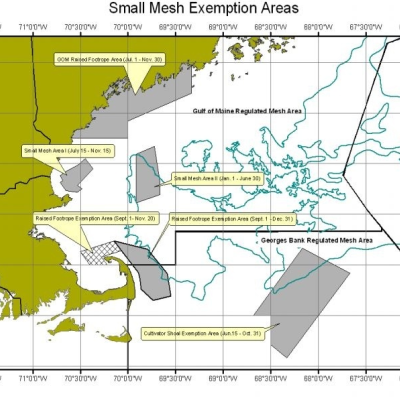
Southern New England Exemption Area
Vessels may fish with small-mesh bottom trawl gear on herring trips in the Southern New England Exemption Area, provided they comply with all applicable gear and possession requirements.
| Area Name | Season | LOA Required? | River Herring/Shad Retention Allowed? |
|---|---|---|---|
| Southern New England Exemption Area | Year-round | No | Yes (alewife, blueback herring, American shad, hickory shad) |

Mid-Atlantic Regulated Mesh Area
Vessels may fish with small-mesh bottom trawl gear on herring trips in the Mid-Atlantic Regulated Mesh Area, provided they comply with all applicable gear and possession requirements.
| Area Name | Season | LOA Required? |
| Mid-Atlantic Regulated Mesh Area | Year-round | No |

Last updated by NOAA Fisheries on 12/23/2025
Industry-Funded Monitoring
Current Status of Herring Industry-Funded Monitoring (IFM)
On November 2, 2022, NOAA Fisheries announced that the IFM program in the herring fishery would be suspended starting on April 1, 2023. Therefore, beginning on April 1, 2023, NOAA Fisheries will no longer select VMS-declared herring trips for IFM coverage. Additionally, NOAA Fisheries will no longer administer the herring electronic monitoring (EM) and portside sampling exempted fishing permit (EFP) for herring vessels. The herring IFM program will remain suspended until federal funding becomes available to cover NOAA Fisheries’ cost responsibilities associated with administering the program. If and when such federal funding becomes available, NOAA Fisheries will work with the New England Fishery Management Council to evaluate how and when to resume the IFM program, and future decisions about the timing of the program will be announced before coverage resumes.
Herring IFM During 2020–2023
Establishment of the Herring IFM Program
On February 7, 2020, NOAA Fisheries published a final rule approving and implementing the New England Industry-Funded Monitoring (IFM) Omnibus Amendment. Among other measures, the IFM Amendment established a new IFM program in the herring fishery. Under this program, vessels issued a Category A (All Areas) or Category B (Areas 2/3) herring permit had to secure at-sea monitoring (ASM) coverage from a NOAA Fisheries-approved service provider on declared herring trips that were selected for IFM coverage. The target IFM coverage rate for herring vessels was 50 percent of VMS-declared herring trips. This coverage rate included a combination of SBRM and IFM coverage. The IFM year runs from April 1 through March 31.
IFM Implementation History
NOAA Fisheries intended to implement IFM in the herring fishery and begin selecting vessels issued Category A or B herring permits for IFM coverage on April 1, 2020. However, the health mandates and travel restrictions that were in place at the time delayed implementation of IFM in the herring fishery until July 1, 2021. For more information and past updates on the herring IFM program, please see the following resources:
- January 29, 2020: Bulletin announcing the approval of the IFM Amendment.
- February 12, 2020: Bulletin requesting applications for IFM service providers for IFM years 2020–2021.
- March 30, 2020: Email requesting participants for the 2020–2021 herring EM EFP.
- March 31, 2020: Email update on notification requirements and timing of IFM implementation.
- March 31, 2020: Bulletin describing revised notification, reporting, and monitoring requirements for the herring fishery.
- June 5, 2020: Email update on timing of IFM implementation.
- October 22, 2020: Email reminder about midwater trawl vessels fishing inside of Groundfish Closed Areas.
- October 30, 2021: Bulletin requesting applications for IFM service providers for IFM year 2021.
- March 7, 2022: Bulletin requesting participants for the 2022 herring EM EFP.
- November 2, 2022: Bulletin announcing the upcoming suspension of the IFM program.
- March 9, 2023: Bulletin reminder about the upcoming suspension of the IFM program.
- September 7, 2023: Bulletin announcing the status of industry cost reimbursement for herring IFM.
Herring EM EFP
On July 1, 2021, NOAA Fisheries issued an EFP authorizing participating vessels to use a combination of EM and portside sampling instead of at-sea monitoring in order to satisfy their IFM coverage requirements during IFM year 2021 (July 1, 2021 to March 31, 2022). On March 30, 2022, we reissued the EFP to cover IFM year 2022 (April 1, 2022 to March 31, 2023).
Under the EFP, participating vessels were required to run their EM systems on 100 percent of declared herring trips. Instead of at-sea monitoring, participating vessels were required to secure portside sampling services from a NOAA Fisheries-approved service provider on trips that were selected for IFM coverage. Participating vessels were also required to land at a NOAA Fisheries-approved sampling station on trips that were portside sampled. The EFP did not exempt participating vessels from SBRM coverage requirements, so participants were still required to carry a NEFOP observer in addition to running their EM systems on herring trips that were selected for SBRM coverage.
Notification, Reporting, and Monitoring Requirements
Beginning on April 1, 2020, vessels were required to adhere to revised notification, reporting, and monitoring requirements for the herring fishery. This included (but was not limited to) a new requirement to notify NOAA Fisheries via the pre-trip notification system (PTNS) at least 48 hours prior to beginning any trip to be considered for IFM or SBRM coverage. Herring vessels must continue to comply with the notification, reporting, and monitoring requirements for the fishery while the IFM program is suspended.
Approved IFM Providers
On April 14, 2020, NOAA Fisheries announced the approval of four companies to provide IFM services to herring vessels in IFM years 2020 and 2021. NOAA Fisheries announced on February 9, 2022 that the same approved four companies were again approved to provide IFM services to herring vessels in IFM years 2022 and 2023.The following companies were approved to provide the listed services during 2020–2023:
- Saltwater Inc: Portside sampling.
- East West Technical Services LLC: Industry funded observer, ASM, portside sampling.
- A.I.S., Inc: Industry funded observer, ASM, portside sampling.
- Fathom Resources, LLC: Industry funded observer, ASM, portside sampling.
Fishing in Groundfish Closed Areas
During July 1, 2021 - March 31, 2023, if a herring trip was not selected for IFM or SBRM coverage, herring vessels had the option to pay for supplemental observer coverage (or portside sampling coverage, for vessels enrolled in the herring EM EFP) in order to fish inside of certain groundfish closed areas with midwater trawl gear. However, the option to pay for supplemental observer coverage in order to access groundfish closed areas is not available while the IFM program is suspended. Therefore, beginning on April 1, 2023, vessels may only fish with midwater trawl gear inside groundfish closed areas on herring trips if the following criteria are met:
- The vessel declares its intent to fish in groundfish closed areas.
- The trip is assigned SBRM coverage in PTNS.
- The vessel carries a NEFOP observer on the trip.
Last updated by NOAA Fisheries on 12/23/2025
Management Overview
How is this fishery managed?
The herring fishery is managed through an annual catch limit (ACL) that is allocated to four distinct management areas (sub-ACLs, also known as management area quotas).
What are the different management areas for the herring fishery?
Area 1A – Inshore Gulf of Maine
Area 1B – Offshore Gulf of Maine
Area 2 – South Coastal Area
Area 3 – Georges Bank
For a map of these areas, please visit our herring regulated and closed areas page.
Who manages this fishery?
Herring is managed in federal waters by the New England Fishery Management Council and NOAA Fisheries. Herring is managed in state waters by the Atlantic States Marine Fisheries Commission and individual states. Individual states may set different regulations, such as possession/landing restrictions or spawning area closures. If state regulations differ from federal regulations, herring permit holders must adhere to the more restrictive regulations.
What is the fishing year for this fishery?
January 1 – December 31
How often do the quotas change for this fishery?
Specifications are set every three years for the herring fishery. The specifications from the previous year roll over if specifications are not in place at the start of the fishing year. NOAA Fisheries may also make adjustments to herring fishery specifications during the fishing year as required by the herring regulations (e.g., adjustments to account for catch overages and carryover of unharvested catch from a management area).
What is the control date for this fishery?
September 16, 1999
What time of year are Atlantic herring most commonly found?
The fishery generally follows herring as they migrate. Fishing in the southern portion of herring’s range (especially off the coast of New Jersey) is common in the winter, while fishing on Georges Bank and in the Gulf of Maine is more common between May and November.
What is the geographic extent of the fishery?
Herring are distributed from North Carolina to Maine and from inshore to offshore waters to the edge of the continental shelf. The species is most abundant north of Cape Cod and has become increasingly scarce south of New Jersey. The majority of the harvest comes from federal waters.
At what depths are herring found?
Adult Atlantic herring are found in shallow inshore waters (20 meters deep) to offshore waters up to 200 meters deep.
What gear types are primarily used for herring?
Trawls (bottom and mid-water, single and paired), purse seines, gillnets, and weirs are the primary gears used by the commercial herring fishery.
Management Plans
Regulatory History
Management Timeline
1972-1976 – Herring is managed by the International Commission for the Northwest Atlantic Fisheries
1976-1978 – NOAA Fisheries regulates international fishing through a preliminary fishery management plan
1978 – United States adopts its own management plan to manage herring stocks on Georges Bank and in the Gulf of Maine, achieve higher levels of spawning biomass and stable recruitment, and rebuild the juvenile herring resource and sardine fishery in the Gulf of Maine
1982 – NOAA Fisheries rescinds the 1978 management plan because of conflicts between state and federal regulations
1982 – Herring is placed on prohibited species list, eliminating directed fisheries for the species by international fleets within the U.S. federal waters and requiring any herring bycatch be discarded
1983 – Atlantic States Marine Fisheries Commission adopts Interstate Fishery Management Plan for Atlantic Herring
Mid-1980s – Georges Bank herring population begins to rebuild
1994 – Atlantic States Marine Fisheries Commission adopts a management plan for herring to address the growth of the herring resource and interest in Internal Water Processing operations
1999 – Atlantic States Marine Fisheries Commission adopts Amendment 1 to the herring management plan to complement the federal management plan in development at the time by the New England Fishery Management Council
2000 – NOAA Fisheries implements Federal Atlantic Herring Fishery Management Plan in conjunction with the New England Fishery Management Council
2006 - Atlantic States Marine Fisheries Commission adopts Amendment 2 to complement Amendment 1 in development at the time by the New England Fishery Management Council.
2007 – Amendment 1 implemented a limited entry for herring vessels, a seasonal purse seine/fixed gear only area in the inshore Gulf of Maine, a three-year specification process, and addressed other management measures for herring.
2008 – Amendment 2 implemented the Standardized Bycatch Reporting Methodology as a part of an Omnibus Amendment.
2011 – Amendment 4 implemented annual catch limits and accountability measures in the herring fishery.
2011 – Herring Regulatory Amendment implemented daily catch reporting for limited access herring vessels using vessel monitoring systems, weekly fishing vessel trip report reporting, and other catch reporting measures.
2013 – Framework 2 allowed the Council to split annual catch limits seasonally for the four Atlantic herring management areas, and carryover up to 10 percent of unharvested catch for each area's ACL.
2014 – Amendment 5 implemented measures revising fishery management program provisions (reporting, definitions, etc.); expanding vessel requirements associated with observer sampling; minimizing slippage; addressing the incidental catch and bycatch of river herring; and revising the criteria for midwater trawl vessel access to Groundfish closed areas.
2014 – Framework 3 established a process for setting river herring and shad catch caps in the herring fishery.
2015 - Amendment 6 established standards of precision for bycatch estimation for all New England and Mid-Atlantic fisheries.
2016 – Framework 4 implemented measures addressing slippage in the herring fishery.
2018 – Amendment 3 updated measures to protect Essential Fish Habitat for all federally managed species. This amendment modified some Groundfish Closed Areas, in some cases allowing the herring fishery greater access to these grounds.
2020 – The New England Industry-Funded Monitoring (IFM) Omnibus Amendment established industry-funded monitoring for the herring fishery and established a 50 percent combined monitoring coverage target for vessels issued Category A or B herring permits (IFM coverage +SBRM coverage = 50%).
2020 – Framework 6 established allowable 2020-2021 herring harvest levels and river herring and shad catch caps, consistent with the Atlantic Herring FMP. The specifications and management measures are necessary to meet conservation objectives while providing sustainable levels of access to the fishery.
2021 – Amendment 8 implemented measures to provide a long-term ABC control rule for the Atlantic herring fishery that will explicitly account for herring’s role in the ecosystem and to address the biological and ecological requirements of the Atlantic herring resource. Amendment 8 also included measures to address potential localized depletion and user conflicts with possible detrimental biological and socioeconomic impacts on predators of herring and other user groups. A March 2022 court order subsequently vacated the inshore midwater trawl restricted area provisions that were implemented through Amendment 8.
2021 - Framework 8 reduced the Atlantic herring quotas for 2021–2023 as compared to 2020.This action modified in-season management measures to allow the Atlantic herring fleet more access to the Atlantic mackerel fishery.
2021 – Framework 9 implemented a rebuilding plan for herring and adjusted accountability measures when catch limits are exceeded.
2023 - The interim final rule implementing 2023-2025 herring fishery specifications updated herring fishery specifications, removes possession limits in Herring Management Area 1B and Area 3, adjusts 2023 fishery specifications and implemented a number of additional management measures.
Under Development
2019 – Framework 7 - The Council has initiated a framework action to address spawning on Georges Bank. During its September 2022 meeting, the Council voted not to work on development of this action in 2023.
2023 – Amendment 10 - The Council initiated an amendment to minimize user group conflicts, achieve optimum yield, support herring rebuilding, and enhance river herring and shad avoidance measures.
More Information
Last updated by NOAA Fisheries on 12/23/2025
Science Overview
NOAA Fisheries conducts various research activities on the biology, behavior, and population health of Atlantic herring. The results of this research are used to inform management decisions for this species.
For detailed information about stock status, management, assessments, and resource trends, you can search for Atlantic herring, and any other species of interest, using NOAA’s StockSMART web tool.
Atlantic Herring Research in the Northeast
Scientists at the Northeast Fisheries Science Center collect data on herring through bottom trawl surveys as well as a dedicated herring acoustic survey, concentrated on the Georges Bank region. Private research institutions, the science center, and members of the lobster fishing industry—who have an interest in the herring resource as a bait source—have conducted acoustic herring surveys since 1998 using smaller industry vessels. Their sampling is largely concentrated on inshore Gulf of Maine herring stocks.
Stock Assessment Review Index
Fishery Stock Assessments in New England and the Mid-Atlantic provides general information about stock assessments, and the Stock Assessment Review Index contains copies of completed assessment documents.
More Information
Last updated by NOAA Fisheries on 12/23/2025
Documents
Age Determination Methods for Northwest Atlantic Species
This manual documents age determination techniques used by staff at the Woods Hole Laboratory to…
Data & Maps
Herring Inshore Midwater Trawl Restricted Area
This dataset depicts the boundaries of the Inshore Midwater Trawl Restricted Area in ESRI shapefile…
River Herring Monitoring-Avoidance Areas - September-October
This dataset depicts the boundaries of the September-October River Herring Monitoring-Avoidance…
River Herring and Shad Catch Cap Closure Areas
This dataset depicts the boundaries of the River Herring and Shad Catch Cap Closure Areas.
River Herring and Shad Catch Cap Areas
This dataset depicts the boundaries of the River Herring and Shad Catch Cap Areas.
Research
Ecosystem and Socioeconomic Profile Development and Reports
Status of Ecosystem and Socioeconomic Profiles for Northeast fishery stock assessments.
Last updated by NOAA Fisheries on 12/23/2025
